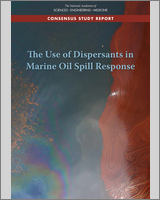From: CHAPTER 1, INTRODUCTION

NCBI Bookshelf. A service of the National Library of Medicine, National Institutes of Health.
Modern dispersants consist of a mixture of surface active agents (surfactants) dissolved in a solvent or mixture of solvents. In standardized tests, eight dispersants listed on the U.S. Environmental Protection Agency National Contingency Plan Product Schedule were generally classified as slightly toxic to practically nontoxic based on acute toxicity to two species, Menida beryllina and Mysidopsis bahia (Hemmer et al., 2011). Dispersants can be applied through various methods depending on the type of delivery platforms available. (See NRC [2005] for a more complete discussion.) Ingredients often include:
NOTE: Nonylphenol ethoxylates are present in some commercial formulations, but these are generally less acceptable to regulatory authorities because of the concern that they may break down to a nonylphenol, which may pose reproductive health and chronic aquatic toxicity concerns.
From: CHAPTER 1, INTRODUCTION

NCBI Bookshelf. A service of the National Library of Medicine, National Institutes of Health.